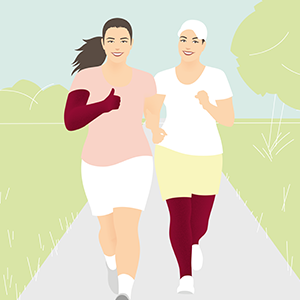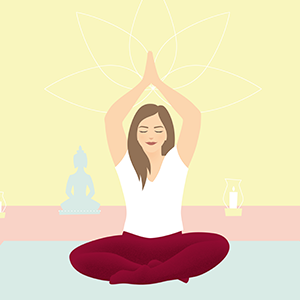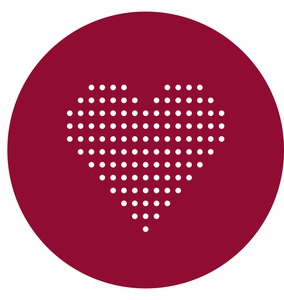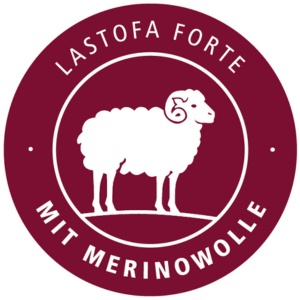Components of self-management
What’s really important during lipedema and lymphedema treatment
In recent times, self-management has become the fifth component of complex decongestive physiotherapy (CDP) – the most effective type of lipedema and lymphedema treatment. Adhering to these five elements is the prerequisite for living an almost completely self-sufficient life despite a chronic illness.
But what is self-management all about?
Self-management in the context of lipedema and/or lymphedema describes the proactive organisation of the everyday life affected by the illness. Through the involvement of different specialists across the treatment chain, such as a doctor, therapist and an employee at the health care supply store, patients are educated and trained to live their lives in a self-sufficient manner.
Function and goals of self-management

Components of self-management
Using self-management in the treatment of edema comprises of many techniques which help you define your own life in a reflective and self-sufficient manner. In our opinion, these are the most important components of self-management:
- Self-love:
We think that accepting, appreciating and learning to love yourself and your own body is the key component of self-management. Self-love and a healthy feeling of self-worth help patients to deal with their own requirements and to figure out what their bodies need and what they can do without. In order to promote this self-love, we stitch a little heart into the foot area or the hem sleeve of Lastofa Forte products upon request. It is designed to remind patients that they are important and that their requirements are always at the heart of the therapy. Because patients matter – always!
- Manual lymphatic drainage (MLD):
Manual lymphatic drainage is a physiotherapeutic type of massage which promotes the movement of lymphatic fluid out of the affected areas through targeted hand movements. The liquid is thereby moved to the functioning part of the lymphatic system and can be removed from there. Depending on the patient’s lipedema phase, the manual lymphatic drainage can be performed daily or weekly. But what can be done when the patient cannot make an appointment or when they are planning a longer holiday?
The concept behind self-management can be the solution. One option might be for the patient to learn a few hand movements and techniques themselves to bridge the gap. Alternatively, a close family member or friend could take on the role of lymph drainage therapist during such times. There are different possibilities of further training in this field – seminars, videos and step-by-step manuals step-by-step manuals for example.
Whether it’s via a therapist or the DIY approach: the goal of manual lymph drainage is to free up the central drainage route in the body. These are the areas in the body where particularly large lymph node clusters are gathered. Specifically speaking, this concerns the neck area under the earlobes, the area under the collarbones and armpits as well as the stomach and groin areas. Using the fingers correctly to create circular movements, this technique is an effective way to stimulate the lymphatic system – especially when done in the morning, before you even get up.
- Compression:
After the manual lymphatic drainage, the compression therapy supports the stimulated lymphatic system in draining excess fluid and prevents repeated swelling of the edema. The medical pressure of compression bandages and stockings decreases from the bottom upwards and thereby enables the lymph fluid to be transported towards the intact vessels. This makes for a better removal of the fluid.
Depending on the time of treatment, the compression consists of short-stretch bandages, multi-component bandage systems or individually manufactured compression stockings. While bandages are used in the first phase (the drainage phase), patients are also very dependent on trained therapists in this phase. It is therefore recommended to have a therapist show you how to bandage yourself correctly. You can also find step-by-step instructions on the internet which can help you learn this skill.
In the so-called maintenance phase, the patient will then wear custom-sized medical compression stockings. These are more comfortable to wear and can be put on and taken off autonomously. This allows the patient to decide when to wear, take off, wash and how to integrate the compression garment into their daily life.
Natural materials like merino wool or cotton allow the skin to breath particularly well. They also have further valuable qualities which make the daily wearing of the garments as comfortable as possible.Compression stockings for lipedema and lymphedema
- Exercise:
Exercise can help to prevent the development of further fatty deposits. Exercise can also prevent the additional development of secondary lymphoedema (often referred to as ‘lipo-lymphedema’).
These types of sport are particularly well-suited for lipedema patients:
- Exercising in water: Whether it’s swimming aqua cycling, aqua fitness, aqua walking or water gymnastics – exercising in water is not only low-impact, but also very effective. That’s because the water pressure acts like a lymphatic drainage and helps to clear the fluid in the affected limbs.
- Trampolining: This is another very effective type of sport that goes easy on your body. The bouncing does not only strengthen your muscles but also stimulates the lymph flow – and let’s not forget that it also boosts the burning of fat.
- Nordic walking: This exercise trains a variety of muscle groups and even includes the arms – an area which is sometimes affected by lipedema. The walking with sticks is particularly gentle on the joints and can be learned quickly by beginners.
- Cross trainer: Effective endurance training that is easy on the body can also be achieved with equipment like the cross trainer. Amongst other muscle groups, it trains the legs, arms, core and glutes. Unlike jogging, this type of exercise does not cause any stress on the joints.
For all kinds of exercise, it’s recommended that compression garments or bandages be worn. The compression supports the muscles, veins and the lymphatic system in transporting blood towards the heart and lymphatic fluid towards the lymph nodes.
- Skincare:
An edema patient’s natural skin barrier can be damaged. This makes the skin prone to infections and poorly healing inflammations. The necessary compression therapy can dry out the skin further. It’s then possible for germs to penetrate the skin via flaky or cracked skin, where they may eventually cause inflammation.
To prevent these side effects, daily skin care is necessary. Every morning and evening, the affected areas should be cleaned and cared for with pH-neutral products. The cream mousses by the brand Callusan work well for this, for example. If unusual changes still occur, such as red skin, you should consult your doctor at your earliest convenience.
Foot care is also important: short nails and few to no calluses ensure the compression garment can be worn without further restrictions. It also helps to prevent ladders from appearing.

- Nutrition:
It’s a fact that an unhealthy diet and obesity can make the edema worse. Fewer pounds mean fewer symptoms. This doesn’t mean that a different nutrition or dieting will heal the edema. But: a healthy diet and a normal weight are important factors for making you feel good.
What am I allowed to eat? What is good for me and my body? There’s no single answer to these questions as every patient is different from the next. That’s why nutrition counselling can be the key to success. However, as you’d normally have to pay this out of your own pocket, it might be better to consult a specialist doctor, create a nutritional plan and to precisely document what you are consuming and when. This way, you can evaluate the outcome after 8 to 12 weeks and adjust your diet accordingly.
Generally speaking, the following applies: less fat and sugar and instead, more fibre (like vegetables, legumes etc.) helps to shift some extra, unnecessary pounds. Do without salt as much as possible, choose sour instead of sweet food and drink at least two litres of liquid per day.
Find out more about ‘lipedema and nutrition’
- Clothes:
Although it ultimately comes down to who we are on the inside, clothes are still an important part of who we are. We use them to communicate with others, even if we don’t consciously intend to. Feelings, purpose, preferences – all these are expressed through our choice of clothing. What’s more, clothes can be an important tool used to increase our self-esteem. That’s why we recommend patients choose compression garments that match their personal style and wardrobe.
Increase the feel-good factor further with these tips:
- Loose and lightweight clothes give you enough freedom of movement and don’t cut into your skin. This enables correct lymph drainage.
- Shoes with a low heel, low footbed and without any uncomfortable seams increase the well-being.
- Clothes with tight elastic bands should be avoided, especially in the waist and groin area. Instead, choose underwear with wide waistbands. When choosing a bra, designs with wider straps that don’t cut into your ribcage or shoulders are also a more comfortable option.
- Jumper sleeves should be wide enough to not restrict your vessels. You should also avoid wearing watches and jewellery on your arms and hands when they are swollen.

Goals of self-management
The goal of self-management is for edema patients to independently manage their illness. This way, they achieve maximum freedom and independence which allows them to consistently continue their edema prevention at all times – on holiday, for example. This continuously promotes the general health and holiday-goers will not have to start from scratch again.
By increasing one’s own awareness and learning the right methods through specialists from the treatment chain, patients can learn to act in a reflective, responsible and healthy manner. However, this does require doctors, therapists, health care supply stores and the patient themselves to work together. Lymph networks, such as the Lymphnetz Mitteldeutschland, are particularly notable when it comes to such cooperation.
With our #LoveYourself challenge, we’re showing you how you can increase your self-esteem further. Why? Because we think that self-love is the driving factor behind the self-management of chronic diseases.
To the #LoveYourself challenge






